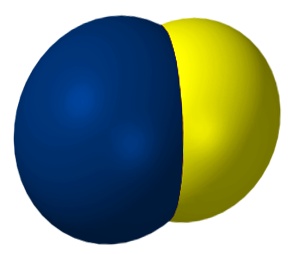Diatomic molecules are molecules made of two atoms chemically bonded together.


The atoms can be of the same element (homonuclear molecules), or of different elements (heteronuclear molecules).
Familiar examples of diatomic molecules of elements are the five gaseous state diatomic elements: Cl2, F2 H2, N2,and O2.
In total, seven elements are known to be diatomic at room temperature; the others are Br2 (liquid) and I2 (solid).
Familiar examples of diatomic molecules containing different elements are hydrogen chloride (HCl), carbon monoxide (CO) and nitrogen monoxide (NO).
Bonding in Diatomic Molecules
In homonuclear diatomic molecules, the bonding is covalent. Each atom in the molecule has equal electronegativity; electrons are shared equally between the two atoms.
In heteronuclear diatomic molecules, the atoms differ in electronegativity; these molecules have polar covalent bonds. The molecule forms a dipole.
Some compounds have formulas that might suggest they are diatomic molecules, such as NaCl. In fact, rather than sharing electrons to form molecules, sodium chloride is a product of ionization. Under normal conditions, ionic compounds do not form diatomic molecules. At room temperature, most exist as large networks of ions arranged in crystal lattices. For example, in the case of solid sodium chloride, each ion is surrounded by six oppositely charged ions in a huge network of ions.
In the gas phase, however, NaCl can exist as a diatomic molecule with a polar covalent bond.